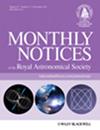Relativistic SZ temperatures and hydrostatic mass bias for massive clusters in the FLAMINGO simulations
IF 4.8
3区 物理与天体物理
Q1 ASTRONOMY & ASTROPHYSICS
引用次数: 0
Abstract
The relativistic Sunyaev-Zel’dovich (SZ) effect can be used to measure intracluster gas temperatures independently of X-ray spectroscopy. Here, we use the large-volume FLAMINGO simulation suite to determine whether SZ y-weighted temperatures lead to more accurate hydrostatic mass estimates in massive ($M_{\rm 500c} \gt 7.5\times 10^{14}\, {\rm M}_{\odot }$) clusters than when using X-ray spectroscopic-like temperatures. We find this to be the case, on average. The median bias in the SZ mass at redshift zero is $\left\langle b \right\rangle \equiv 1-\left\langle M_{\rm 500c,hse}/M_{\rm 500c,true} \right\rangle = -0.05 \pm 0.01$, over 4 times smaller in magnitude than the X-ray spectroscopic-like case, $\left\langle b \right\rangle = 0.22 \pm 0.01$. However, the scatter in the SZ bias, $\sigma _{b} \approx 0.2$, is around 40 per cent larger than for the X-ray case. We show that this difference is strongly affected by clusters with large pressure fluctuations, as expected from shocks in ongoing mergers. Selecting the clusters with the best-fitting generalized NFW pressure profiles, the median SZ bias almost vanishes, $\left\langle b \right\rangle = -0.009 \pm 0.005$, and the scatter is halved to $\sigma _{b} \approx 0.1$. We study the origin of the SZ/X-ray difference and find that, at $R_{\rm 500c}$ and in the outskirts, SZ weighted gas better reflects the hot, hydrostatic atmosphere than the X-ray weighted gas. The SZ/X-ray temperature ratio increases with radius, a result we find to be insensitive to variations in baryonic physics, cosmology, and numerical resolution.FLAMINGO 模拟中大质量星团的相对论 SZ 温度和流体静力学质量偏差
相对论苏尼亚耶夫-泽尔多维奇(SZ)效应可用于测量星团内气体温度,而不依赖于X射线光谱。在这里,我们使用大容量的FLAMINGO模拟套件来确定SZ y加权温度是否会比使用类似X射线光谱的温度更准确地估计大质量($M_{\rm 500c} \gt 7.5\times 10^{14}}, {\rm M}_{\odot }$)星团的静水质量。我们发现平均来说情况就是这样。在红移为零时,SZ质量的中位偏差是 $\left\langle b \right\rangle \equiv 1-\left\langle M_{\rm 500c,hse}/M_{\rm 500c,true}.\right\rangle = -0.05 \pm 0.01$,比类似 X 射线光谱的情况($\left\langle b \right\rangle = 0.22 \pm 0.01$)小 4 倍多。然而,SZ偏差的散度,$\sigma _{b} (约 0.2\约为 0.2$,比 X 射线情况下大 40%左右。我们的研究表明,这种差异在很大程度上受到了压力波动较大的星团的影响,如正在进行的合并中的冲击所预期的那样。选择具有最佳拟合广义NFW压力曲线的星团,SZ偏差的中值几乎消失了,$\left\langle b \right\rangle = -0.009 \pm 0.005$,散度减半,为$\sigma _{b} (约0.1%)。\大约 0.1$。我们研究了SZ/X射线差异的起源,发现在$R_{\rm 500c}$和外围,SZ加权气体比X射线加权气体更好地反映了热的静压大气。SZ/X射线温度比随半径增加而增加,我们发现这一结果对重子物理学、宇宙学和数值分辨率的变化并不敏感。
本文章由计算机程序翻译,如有差异,请以英文原文为准。
求助全文
约1分钟内获得全文
求助全文
来源期刊

Monthly Notices of the Royal Astronomical Society
ASTRONOMY & ASTROPHYSICS-
CiteScore
9.10
自引率
37.50%
发文量
3198
审稿时长
3 months
期刊介绍:
Monthly Notices of the Royal Astronomical Society is one of the world''s leading primary research journals in astronomy and astrophysics, as well as one of the longest established. It publishes the results of original research in positional and dynamical astronomy, astrophysics, radio astronomy, cosmology, space research and the design of astronomical instruments.
 求助内容:
求助内容: 应助结果提醒方式:
应助结果提醒方式:


